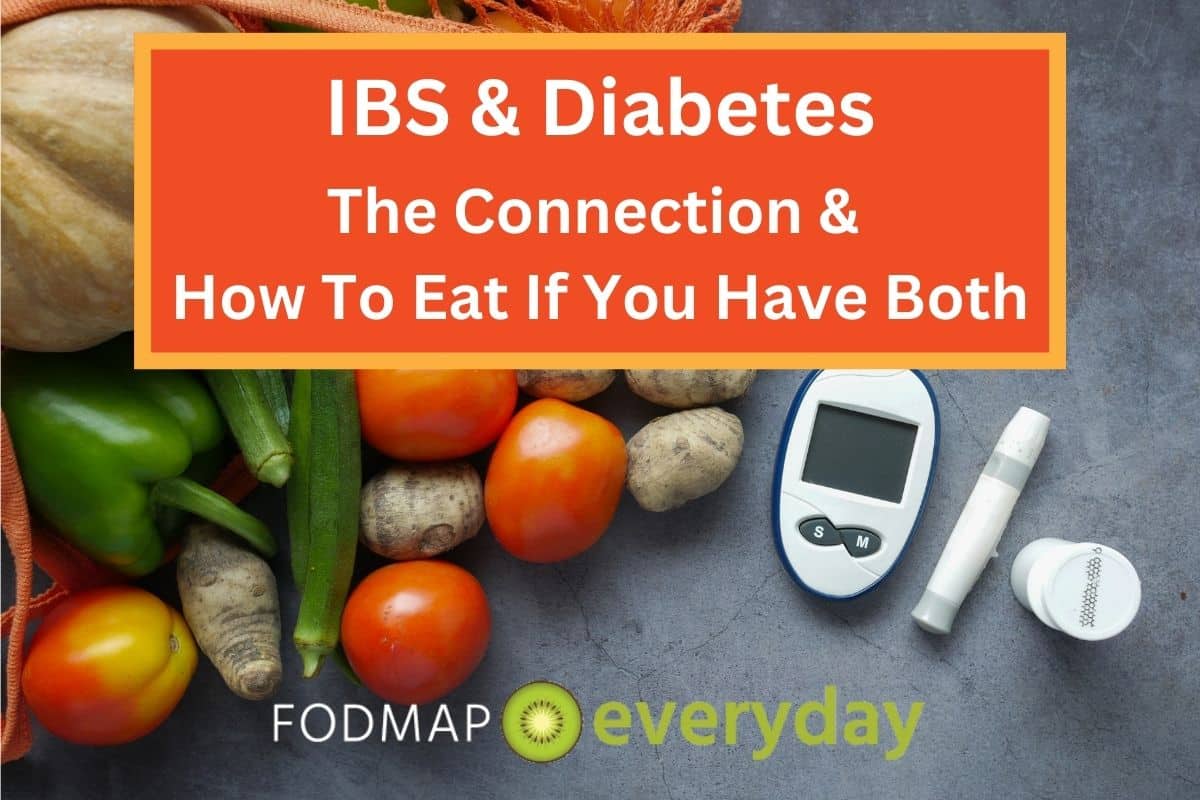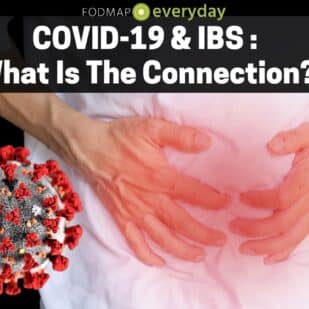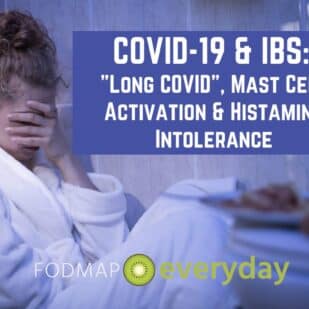Do you have Irritable Bowel Syndrome (IBS)? Have you also been diagnosed with type 2 diabetes or prediabetes? And so you’re wondering… What the heck do I eat now?
Standard recommendations for diabetes are a high fiber diet, removing added sugars, and spacing out your carbohydrates. Sure, seems “doable” with some extra planning. But then add on trying to follow a low FODMAP diet for your IBS and that adds a whole other layer of complication!

Furthermore, you might be thinking that these conditions are completely unrelated. However, as it turns out, there may actually be more connection between your gut and insulin resistance than you thought!
In this article we will explain what these two connections are, the fascinating connection between IBS, the gut microbiome and diabetes, and management strategies that can help you manage both of these conditions.
What is IBS?
IBS is a chronic, functional gut disorder characterized by abdominal pain or discomfort along with a range of other symptoms, including bloating, diarrhea, constipation, or alternating episodes of both. Although the exact cause of IBS is not known, this condition is thought to have some underlying drivers of symptoms including dysbiosis (aka imbalance in the gut microbiome), altered motility, disrupted gut-brain connection, and low grade inflammation in the gut.
Learn more about IBS symptoms and causes here.

What is Diabetes?
Diabetes is a chronic disease that occurs when an individual’s blood glucose, aka blood sugars, are too high.
Glucose is a source of energy for our bodies, which we get both from the food we eat, as well as through some production by our bodies. Diabetes occurs due to an issue with the hormone insulin, which acts like a gatekeeper for blood sugar into our cells. In diabetes, the pancreas either does not produce enough insulin, or our cells become ‘resistant’ to insulin and stop letting sugar in. Hence, the sugar builds up in our blood.
High blood sugars pose many risks, as it can cause our blood to become more thick and put stress on our blood vessels, tax our kidneys, and cause damage to nerve endings.
For this article, we will focus on type 2 diabetes and prediabetes, which tend to occur in adulthood and are considered ‘lifestyle diseases’, and can be managed in the early stages without medications.
There are few different types of diabetes, including:
- Type 1 Diabetes: In Type 1 diabetes, the pancreas makes little or no insulin. It is an autoimmune condition where the body attacks its own pancreas cells. People with type 1 diabetes must take insulin daily to stay alive. There is no known prevention for type 1 diabetes, it is caused by having a certain gene variant and/or environmental trigger causing an auto-immune response.
- Type 2 Diabetes: In type 2 diabetes, the most common form, the pancreas may still make insulin, however the cells have become resistant to insulin. Type 2 diabetes is considered a ‘lifestyle disease’, meaning it can be prevented through diet and lifestyle. However, risk increases with age, family history, and having other health conditions.
- Prediabetes: In prediabetes, an individual’s blood sugar averages are higher than normal, however not yet high enough to be considered diabetes. Someone with prediabetes is at high risk of developing type 2 diabetes or gestational diabetes.
- Gestational diabetes: Gestational diabetes occurs during pregnancy, and often goes away after delivery. Women with gestational diabetes are at a higher risk of developing type 2 diabetes later on.
For this article, we will focus on type 2 diabetes and prediabetes, which tend to occur in adulthood and are considered ‘lifestyle diseases’, and can be managed in the early stages without medications.
What’s the Connection Between IBS & Diabetes?
Much research has been done on the connection between the gut microbes and insulin resistance, although not as much has been done on IBS and diabetes specifically. For now, we can speculate on the connection between these conditions based on the connection between the issues that occur with them, however more research is needed.
Low Grade Inflammation
Development of diabetes and IBS are both categorized with low grade inflammation. Inflammation is our bodies natural response to a foreign invader or pathogen. However, chronic inflammation can occur when the immune system is overstimulated all the time. It is not clear exactly what triggers the inflammation in either IBS or diabetes, but diet, high stress levels, and dysbiosis in the gut microbiome (as we will get into below) may be related.
Nerve Damage From Poor Glycemic Control
When blood sugars are not properly controlled for a long period of time, this puts a lot of extra stress on blood vessels and nerve endings in the body. This can lead to damage to nerves, also known as ‘diabetic neuropathy’. Nerves in the gastrointestinal tract can be impacted and can lead to various conditions including gastro-oesophageal reflux disease (GERD), gastroparesis, chronic diarrhea, or incontinence.
These changes may also increase risk for IBS, in which motility (movement) of the small and large intestines are often interrupted.

Gut Microbiota
It turns out that certain types of microbes in your gut can impact insulin sensitivity, and therefore may impact risk of type 2 diabetes and/or management. Let’s get into this one a bit more in depth below.
Gut Microbiome & Insulin Resistance
The gut microbiome is gaining recognition as a potential contributor to metabolic diseases, including obesity and type 2 diabetes. Obesity has been linked to an increase in Firmicutes and Actinobacteria, and a decrease in Bacteroidetes in the host’s microbiome. This change in the microbiome has been shown to increase intestinal permeability and cause a change in inflammatory pathways that have been shown to impair insulin receptors and their sensitivity.
A recent study found that people with higher levels of Coprococcus bacterium were more likely to have higher insulin sensitivity, while those who had higher levels of Flavonifractor bacterium were more likely to have lower insulin sensitivity.

How to Eat When You Have IBS & Diabetes
So now that we’ve got a clear understanding of these two conditions, and the risk factors, let’s discuss ways to manage them through your diet.
Eat Low FODMAP Fiber
Getting enough fiber is essential for maintaining healthy blood sugar balance, as well as a healthy gut microbiome. However, some high fiber foods are also high FODMAP.
Aim to get at least 25-30 grams of fiber per day for women, and 35-40 grams of fiber per day for men.
Low FODMAP fiber sources include:
- Raspberries (58g)
- Edamame (90g)
- Chia seeds (24g)
- Flax (15g)
- Popcorn (120g)
- Kiwi (150g)
- Kabocha squash (75g)
- Quinoa (155g)
- Potatoes (75g)
See our article for more on how to get enough fiber.

Be Mindful of Sugar Substitutes & Sugar-Free Products
Many ‘sugar-free’ ‘keto’ and ‘low carb’ products (bars, chocolates, snacks) are often high FODMAP due to the use of sugar alcohols like xylitol, maltitol, isomalt, sorbitol, and mannitol. They also tend to contain inulin or chicory root fiber to help boost fiber content, however these are also a high FODMAP ingredients.
Furthermore, as per 2023 World Health Organization Guidelines use of Non-Nutritive Sweeteners (aka NNS, or calorie-free sweeteners such as acesulfame K, aspartame, cyclamates, neotame, saccharin, sucralose, stevia) may not actually help with weight control and could potentially increase the risk of type 2 diabetes and obesity longer term. While we still need to learn more, if you have prediabetes and/or are at risk, using these options may do more harm than good.
Here are some tips:
- Look for products without added sweeteners and low in added sugars: For cereals and bars, aim for under 8 grams per serving. White sugar, maple syrup and cane sugar are low FODMAP, but use them sparingly.
- Opt for whole, minimally processed foods most of the time: cook your meals and prepare your snacks at home so you can control the sugar content and ingredients.
- Include natural sources of sweetness that also contain fiber, which helps to slow blood sugar rise: such as yellow-ripe bananas (100g), blueberries (125g), sweet potato (75g), kabocha squash and whole grains like quinoa (155g) in your meals and snacks.
Have Regularly Spaced Meals
Spacing out meals is helpful for both digestion and absorption, as well as supporting stable blood sugar levels. Aim to eat every 3-4 hours as hungry during the daytime. Include fiber, protein and healthy fat at each meal.
It is also helpful to eat during the daytime hours, rather than early morning or late evening for both digestive health as well as metabolic health. See our article on IBS, circadian rhythms and meal timing.
Consume Prebiotic Foods
As we’ve discussed, the health of your microbiome may impact your body’s ability to metabolize sugar (aka insulin sensitivity). Prebiotics are the fuel source for your good gut bacteria, and may help improve insulin sensitivity.
Low FODMAP Prebiotic foods include:
- Oats (50 g)
- Jicama
- Tofu & tempeh
- Yellow-non-spotted bananas (100g)
- Pickled onions (45g)
- Asparagus (12g)
Include Fermented Foods Daily
Fermented foods are pretty amazing! They have been shown to improve gut microbiome diversity, lower markers of inflammation and also may play a role in reducing blood pressure (which is a common comorbidity with diabetes).
Aim to include them regularly in your diet, as they are also blood sugar friendly.
Low FODMAP fermented foods include:
- Kefir (lactose-free)
- Sauerkraut (20g)
- Kimchi (47g)
- Tempeh (100g)
- Miso paste (12g)
- Sourdough bread, wheat or oat (50g)
- Pickles
Learn more about fermented foods HERE.

Intermittent Fasting
We know you all are wondering about intermittent fasting (IF). We can’t talk about diabetes without some mention of this very trendy diet pattern! Here’s the honest scoop – the research on intermittent fasting for glycemic control in type 2 diabetes is controversial.
It has been shown in recent systematic reviews to help with weight loss in those with type 2 diabetes when compared with a standard diet. However when compared with a continuous energy restricted diet (aka participants had their calories reduced), weight changes appear to be the same.
Having intake restricted to 8-hours of the day naturally helps people to reduce their food and overall calorie intake, so it’s more likely that reduced food intake is the biggest factor, rather than any ‘metabolic changes’ that occur through the fasting process.
When it comes to IBS, we know that larger portion sizes and frequent eating can be a trigger for digestive symptoms. So, with the short eating window in intermittent fasting, we don’t recommend this style of eating as the benefits for IBS are neutral at best.
The research on intermittent fasting for glycemic control in type 2 diabetes is controversial….with the short eating window in intermittent fasting, we don’t recommend this style of eating as the benefits for IBS are neutral at best.
When it comes to eating windows and meal timings, what we’ve seen is likely best is to try to eat your meals during the daylight hours when your digestive system is most metabolically active (as it works on a ‘diurnal pattern’). Aim to eat in a similar pattern each day, and try to avoid early morning or late night eating. For a deeper understanding of how your meal timing patterns and eating in tune with your circadian rhythms support metabolic and digestive health, see our article on IBS, circadian rhythms and meal timing.
Lifestyle Changes for Glycemic Control & Digestive Health
There are a few amazing ways you can support BOTH your blood sugars, as well as improve gut health through dietary changes!
This includes:
- Walking: Walking after meals has been shown to improve glycemic control and boost insulin sensitivity. We also know that low-moderate intensity movement helps improve gas clearance and gut motility, aka better digestion!
- Sleep hygiene: Poor sleep has been linked with insulin resistance. We also know sleep is essential for digestive function and motility. Make sleeping at least 8 hours per night a primary goal in your plan to manage IBS and diabetes.
- Stress management: Stress causes a rise in our cortisol levels, a hormone which naturally increases blood sugars. High stress can also be a trigger for IBS flare-ups due to its effect on down regulating the ‘parasympathetic’ nervous system (aka deprioritizing our rest and digest response). P.S. We love Nerva, a gut-directed hypnotherapy app that helps you regulate the connection between your gut and brain.

Work With a Registered Dietitian
Managing two chronic diseases at the same time can be overwhelming! If you need help with meal planning, reducing symptoms and improving your blood sugars, consider working with a specialized dietitian. Registered Dietitians are regulated health professionals and are the experts in nutrition care and medical nutrition therapy. See our Global Dietitian Directory to find the right fit for you.
Conclusion
As you can see, there is a significant connection between IBS and diabetes. While it may seem complicated to manage both, the good news is that there are many overlapping strategies to help both your IBS symptoms as well as improve blood sugar control.
As we’ve mentioned, if you’re wanting to manage both your IBS and diabetes successfully, consider working with a Registered Dietitian on your health journey.
The Takeaway
- Diabetes is a chronic disease that occurs when an individual’s blood glucose, aka blood sugars, are too high. This is due to our bodies levels of the hormone insulin being underproduced, or more commonly in type 2 diabetes, our cells become ‘insulin resistant’.
- IBS and diabetes may be connected through alterations in the gut-microbiome, as a result of diabetic neuropathy to nerves in the GI tract, and chronic inflammation.
- To eat with both IBS and diabetes, be mindful of sugar substitutes, eat regular spaced meals, and include low FODMAP high fiber foods, prebiotics and fermented foods to help support insulin resistance and a healthy microbiome.
- Incorporate lifestyle strategies to support digestion and blood sugar control such as regular walking or other low-moderate intensity movement, sleep hygiene, and stress management.
References:
1. Borgundvaag, E., Mak, J., & Kramer, C. K. (2021). Metabolic Impact of Intermittent Fasting in Patients With Type 2 Diabetes Mellitus: A Systematic Review and Meta-analysis of Interventional Studies. The Journal of clinical endocrinology and metabolism, 106(3), 902–911. https://doi.org/10.1210/clinem/dgaa926
2. Caricilli, A. M., & Saad, M. J. (2013). The role of gut microbiota on insulin resistance. Nutrients, 5(3), 829–851. https://doi.org/10.3390/nu5030829
3. Center for Disease Control and Prevention. (2022, March 11). What Is Type 1 Diabetes?. U.S. Department of Health & Human Services. https://www.cdc.gov/diabetes/basics/what-is-type-1-diabetes.html
4. Cui, J., Ramesh, G., Wu, M., Jensen, E. T., Crago, O., Bertoni, A. G., … & Goodarzi, M. O. (2022). Butyrate-Producing Bacteria and Insulin Homeostasis: The Microbiome and Insulin Longitudinal Evaluation Study (MILES). Diabetes, 71(11), 2438-2446
5. DiPietro, L., Gribok, A., Stevens, M. S., Hamm, L. F., & Rumpler, W. (2013). Three 15-min bouts of moderate postmeal walking significantly improves 24-h glycemic control in older people at risk for impaired glucose tolerance. Diabetes care, 36(10), 3262-3268.
6. Kim, Y. A., Keogh, J. B., & Clifton, P. M. (2018). Probiotics, prebiotics, synbiotics and insulin sensitivity. Nutrition research reviews, 31(1), 35–51. https://doi.org/10.1017/S095442241700018X
7. Kuźnik, E., Dudkowiak, R., Adamiec, R., & Poniewierka, E. (2020). Diabetic autonomic neuropathy of the gastrointestinal tract. Przeglad gastroenterologiczny, 15(2), 89–93. https://doi.org/10.5114/pg.2020.95554
8. National Institute of Diabetes and Digestive and Kidney Diseases. (2023, April). What is Diabetes?. U.S. Department of Health and Human Services, National Institute of Health. https://www.niddk.nih.gov/health-information/diabetes/overview/what-is-diabetes
9. Şanlier, N., Gökcen, B. B., & Sezgin, A. C. (2019). Health benefits of fermented foods. Critical reviews in food science and nutrition, 59(3), 506–527. https://doi.org/10.1080/10408398.2017.1383355
10. Sondrup, N., Termannsen, A. D., Eriksen, J. N., Hjorth, M. F., Færch, K., Klingenberg, L., & Quist, J. S. (2022). Effects of sleep manipulation on markers of insulin sensitivity: A systematic review and meta-analysis of randomized controlled trials. Sleep medicine reviews, 62, 101594. https://doi.org/10.1016/j.smrv.2022.101594
11. Wang, X., Li, Q., Liu, Y., Jiang, H., & Chen, W. (2021). Intermittent fasting versus continuous energy-restricted diet for patients with type 2 diabetes mellitus and metabolic syndrome for glycemic control: A systematic review and meta-analysis of randomized controlled trials. Diabetes research and clinical practice, 179, 109003. https://doi.org/10.1016/j.diabres.2021.109003
12. World Health Organization. (2023, 15 May). WHO advises not to use non-sugar sweeteners for weight control in newly released guideline. https://www.who.int/news/item/15-05-2023-who-advises-not-to-use-non-sugar-sweeteners-for-weight-control-in-newly-released-guideline







